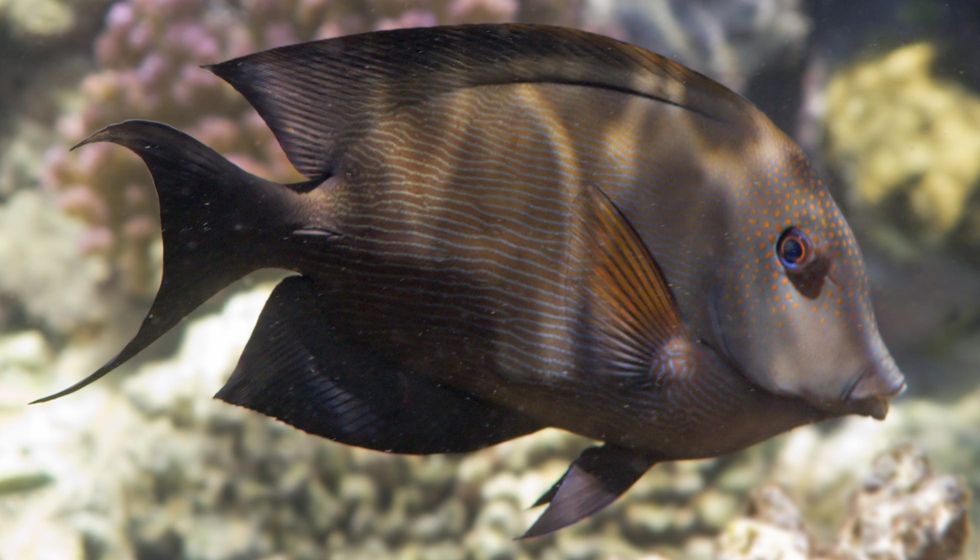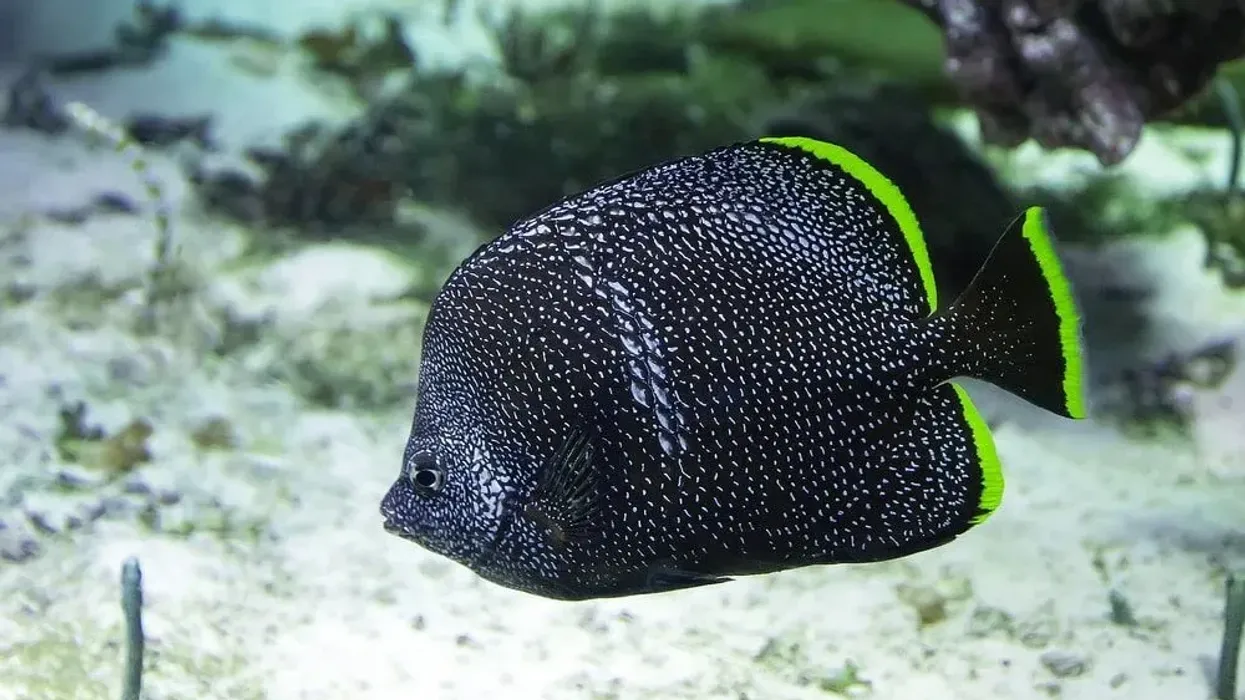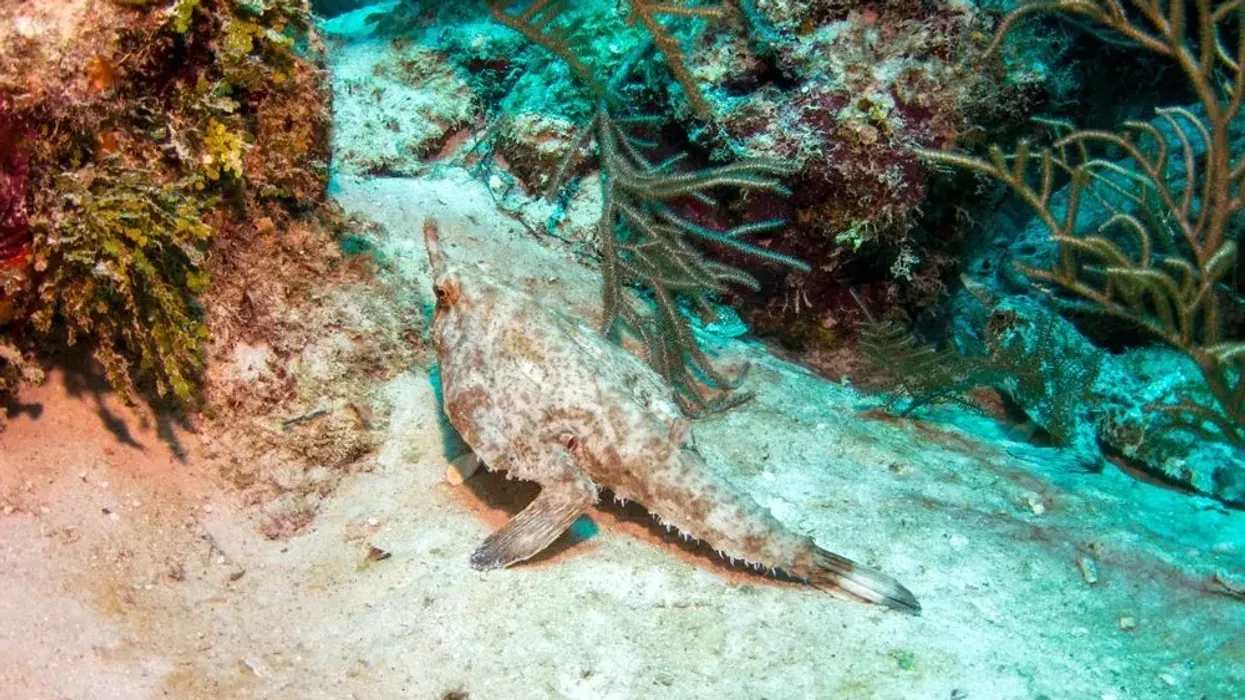The brown surgeonfish (Acanthurus nigrofuscus) is a species of tang in the family Acanthuridae. This species is known by many different names such as lavender tang, brown tang, spot-cheeked surgeonfish, blackspot surgeonfish, brown surgeon, doctorfish, dusky surgeonfish, lavender surgeonfish, elongate surgeonfish, lancetfish, spot-cheeked tang, and thorntail fish.
These fishes are commonly found tangs in the aquarium business and are quite popular. The diet of these tangs includes benthic algae.
A bacteria with the name Epulopiscium fishelsoni has been recently found in the intestines of this surgeon fish. This discovery was made in the March 1993.
This large bacteria is almost the size of a full-stop and is visible to the naked human eye. This bacteria controls the pH of the stomach of the fish and helps digest the food.
Adults are usually found in small groups, but in some distinct oceanic areas, large schools are also formed. This fish species can easily be identified by the brown coloration of the body which has thin bluish-gray horizontal lines.
The brownish-orange coloration is also seen on the dorsal and anal fins. The anal fin has a smaller black spot towards the back near the tail fin, while the dorsal fin has a bigger black spot in comparison. Orange spots on the head and throat are also seen.
This fish found in the Red Sea, Transkei, Tuamoto, South Africa, and the Hawaiian Islands of the Indo-Pacific regions is also seen in southern Japan, New Caledonia, the southern part of the Great Barrier Reef, and Rapa. This is an aggressive territorial species but sometimes schools are seen feeding in mixed groups with convict tangs.
For more relatable content, check out these yellow tang facts and spiny dogfish facts for kids.
Brown Surgeonfish Interesting Facts
What type of animal is a brown surgeonfish?
The brown surgeonfish is a species of tang fish found in Hawaii and the Indo-Pacific region.
What class of animal does a brown surgeonfish belong to?
The brown surgeonfish (Acanthurus nigrofuscus) falls under the class of Actinopterygii in the kingdom of Animalia. The fish species is popular and other names for this tang fish include the spot-cheeked surgeonfish, lavender tang, dusky surgeonfish, and blackspot surgeonfish.
How many brown surgeonfish are there in the world?
The population of the Acanthurus nigrofuscus, or lavender tang, is not known. However, seeing their large range of distribution, this species of fish is not currently in any danger.
Where does a brown surgeonfish live?
The range of distribution of the dusky surgeonfish is limited to the Indo-Pacific waters and the islands of Hawaii. The Indo-Pacific habitats comprise Transkei, South Africa, the Red Sea, Tuamoto, and the Hawaiian Islands.
This fish species, also known by the name blackspot surgeonfish, is also found in southern Japan, Rapa, the southern part of the Great Barrier Reef, and New Caledonia. The fish is always found in groups in these regions.
What is a brown surgeonfish's habitat?
The lavender tang inhabits tropical shallow lagoons with seaward reefs and hard substrates in deeper waters. This marine species is found in the Indo-Pacific waters feeding on filamentous algae.
Juveniles born after spawning hide in crevices in rubble and rocks. After some time, they join schools of other surgeonfishes. These groups feed on the bottom and move around the edges of shallow reef areas.
Who do brown surgeonfish live with?
Brown surgeonfish live in large schools and they are rarely found alone or in pairs. Adults are usually found in smaller groups. Only in a few oceanic habitats do they form larger schools. Juveniles live alone and hidden until they join larger groups. These larger schools are formed for protection. They are considered to be very territorial.
How long does a brown surgeonfish live?
The lifespan of the lavender tang is not known. However, in some cases, females have been known to live for three to 45 years in the wild.
The blue tang can live in the wild for around 30 years, but in captivity, the lifespan reduces to around eight to 12 years.
How do they reproduce?
Similar to all other surgeonfishes, the brown surgeon participates in a mass spawning culture. Spawning is done almost daily from February to early September. Fishes move to the spawning sites from various parts of the reef.
Females are bigger in size than males. They form pairs and spawn in open waters.
After hatching the eggs, the larvae emerge with a long snout and a small mouth and this stage is for 42-68 days. Larvae are also eaten by other fishes and marine animals. The larvae changes to juveniles after 42-68 days.
The species is said to have not been bred in captivity.
What is their conservation status?
The conservation status of the brown surgeonfish (Acanthurus nigrofuscus) is categorized as Least Concern by the IUCN Red List. Though the population of these fishes is not known, they are said to be found abundant in a variety of sea habitats around the world.
They are famous as aquarium fishes too. A little care is needed to conserve this species in the world and let it flourish.
Brown Surgeonfish Fun Facts
What do brown surgeonfish look like?
The shape of the body of this fish looks like a disk. This species is the smallest and the least colorful in the genus.
A drab brown or purple-brown color is seen on the body of this species. Dull small orange spots on the head and throat are seen. The same orange-brown coloration is seen on the dorsal and anal fins.
A black spot is seen on the base of the anal fin and another black spot bigger in size is seen on the dorsal fin. A spine on the tail stem can cause serious pain in the wound. The fish has a blackish-brown lip.
There is a black spot and line near the tail, and the tail looks purplish in light. Thin bluish-gray horizontal lines are also seen on the body.
The colors on the body change when displaying aggression.

*Please note that this is an image of a Sohal surgeonfish, not a brown surgeonfish specifically. If you have an image of a brown surgeonfish, then please let us know at hello@kidadl.com.
How cute are they?
The fish looks beautiful in natural light and the purple coloration is a sight to behold. Even though this fish is one of the dullest ones in the genus, it a popular fish in any aquarium.
How do they communicate?
Fishes are known to communicate via different sounds and colors. They are known to change body color and this body language is a mode of communication with other fishes.
How big is a brown surgeonfish?
The brown surgeonfish is around 8.26 in (21 cm) long. The Achilles tang, part of the same genus as the brown surgeonfish (Acanthurus nigrofuscus), has a range of length between 3-9.8 in (7.6 - 24.8 cm).
How fast can a brown surgeonfish swim?
The swimming speed is not known. The size and shape of the body should make them pretty quick. If predators approach them for feeding, tangs move quicker.
How much does a brown surgeonfish weigh?
The weight of this surgeonfish is not known. The blue tang, a member of the same family Acanthuridae, has a weight up to up to 21.1 oz (600 g).
What are the male and female names of the species?
Males and females are not given different names.
What would you call a baby brown surgeonfish?
In the two life stages of a baby fish after hatching, they are called larvae and juveniles.
What do they eat?
The fish primarily has a diet of benthic algae. They are found feeding on filamentous algae in seaward reefs of deeper waters. This large bacteria found in March 1993 called Epulopiscium fishelsoni helps the fish digest food and also accumulate nutrients. The bacteria is found in the intestines.
In captivity, the spot-cheeked surgeonfish diet can change and it can also be given animal matter like mysis shrimp and brine shrimp.
Are they dangerous?
They are not considered dangerous usually. However, some tangs are poisonous.
Would they make a good pet?
They are a popular aquarium breed because of the temperament and beautiful colors on the body. It is safe to keep brown surgeonfishes in an aquarium with gobies, dartfish, assessors, fairy wrasses, anthias, clownfish, dwarf angels, dottybacks, and damselfish. They should be put in a bigger aquarium setting if being kept with other tang species.
Did you know...
The powder brown surgeonfish is another species in the genus Acanthurus that shares the name with the brown surgeonfish. However, they are different breeds of surgeonfishes.
Some surgeonfishes are edible and some are poisonous.
Brown surgeonfish is not endemic to any particular region.
Why are surgeonfish called surgeonfish?
Surgeonfishes have blade-like spines in the tails which are used for defence. These spines are said to be as sharp as a surgeon's scalpel and so, the name was given to the species.
Humans should be careful of these spines as some species appear to be poisonous.
Is a tang a surgeonfish?
Surgeonfish or doctorfish are names given to tangs. These tangs are wonderful additions to reef-only aquarium tanks.
Here at Kidadl, we have carefully created lots of interesting family-friendly animal facts for everyone to discover! For more relatable content, check out these three spot gourami facts and honey gourami facts for kids.
You can even occupy yourself at home by coloring in one of our free printable brown surgeonfish coloring pages.










